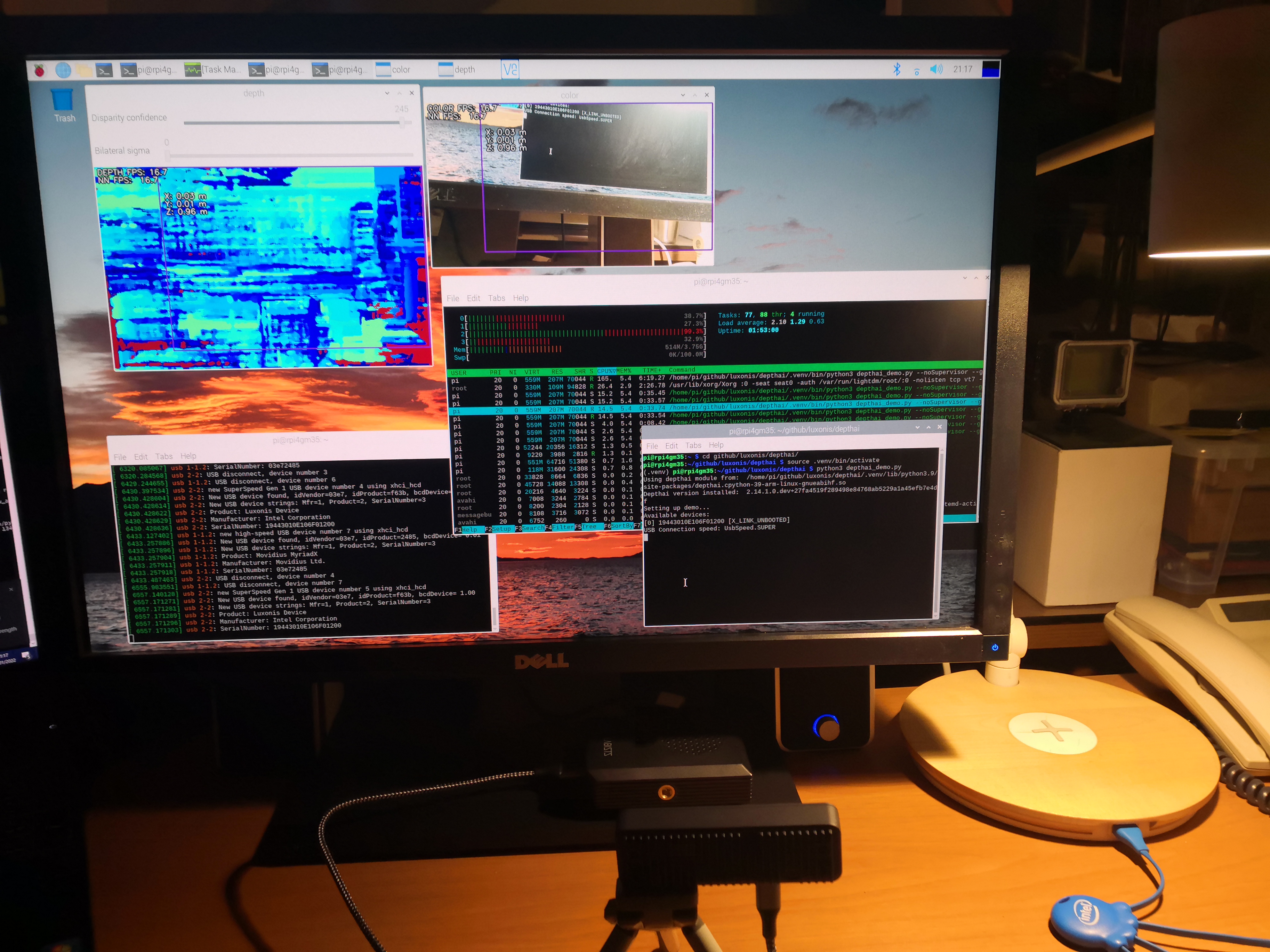HOWTO Install DepthAI on a Raspberry Pi 4B for the ARNEIS project
Introduction
The following document explains how to install Luxonis DepthAI software on a Raspberry Pi for the ARNEIS project.
Prerequisites
One Raspberry Pi prepared as detailed in “HOWTO Prepare a Raspberry Pi 4B for the ARNEIS project”.
Tested on rpi4gm35 (Raspberry Pi 4B 4GB)
One MicroSD card of at least 4GB.
IMPORTANT: The card should be blank, or at least should not contain any important data since it will be completely erased.
Tested with a SanDisk Ultra 256 GB MicroSDXC
One desktop PC or laptop for formatting the SD card and controlling the RPi
OS: A recent version of Windows or Linux or macOS
The PC should have a MicroSDHC card reader. Alternatively, an additional USB MicroSD card reader is required
Fast internet connection
Step-by-step instructions
Prepare the Raspberry Pi
Follow the instructions at https://arneis.readthedocs.io/en/latest/howto/howto-prepare-rpi4b-for-arneis.html.
Install DepthAI
Reference: https://docs.luxonis.com/en/latest/pages/tutorials/first_steps
Logged in as pi@rpi4gm35, type the following command to install DepthAI software:
sudo apt update
sudo apt install -y python3-pip python3-venv
mkdir -p ~/github/luxonis
cd ~/github/luxonis
git clone https://github.com/luxonis/depthai.git
Now create a Python virtualenv:
cd ~/github/luxonis/depthai
python3 -m venv virtualenv
source virtualenv/bin/activate
pip install -U pip
Install requirements:
python3 install_requirements.py
Install some missing binary packages (for some unknown reasons neither pip nor virtualenv automatically install them)
sudo apt-get -y install libatlas-base-dev python3-h5py
Add a new udev rule for the script to be able to access the OAK-D-Lite device correctly.
echo 'SUBSYSTEM=="usb", ATTRS{idVendor}=="03e7", MODE="0666"' \
| sudo tee /etc/udev/rules.d/80-movidius.rules
sudo udevadm control --reload-rules \
&& sudo udevadm trigger
Check Linux kernel messages
sudo dmesg -w
Connect the OAK-D-Lite to one USB 3.0 port of the Raspberry Pi using a USB 3.0 cable (USB-A to USB-C).
As soon as the OAK-D-Lite gets recognize the following messages should be displayed on the kernel log:
[ 5253.298901] usb 1-1.2: new high-speed USB device number 4 using xhci_hcd
[ 5253.429951] usb 1-1.2: New USB device found, idVendor=03e7, idProduct=2485, bcdDevice= 0.01
[ 5253.429971] usb 1-1.2: New USB device strings: Mfr=1, Product=2, SerialNumber=3
[ 5253.429987] usb 1-1.2: Product: Movidius MyriadX
[ 5253.430002] usb 1-1.2: Manufacturer: Movidius Ltd.
[ 5253.430017] usb 1-1.2: SerialNumber: 03e72485
Run the demo script
python3 depthai_demo.py
Result: The depthai_demo.py program is executed correctly on the Raspberry Pi.

Note 1: First execution of depthai_demo.py
The first time that depthai_demo.py is launched, it may take a few minutes before the camera windows are be displayed.
Note 2: Launching depthai_demo.py from a remote shell
The depthai_demo.py script should be invoked from a terminal on the main Raspberry Pi display.
If the command is invoked from a remote SSH shell, make sure that the DISPLAY environment variable is properly set before launching the demo script.
Example:
(.venv) pi@rpird102:~/github/luxonis/depthai $ export DISPLAY=:0.0
(.venv) pi@rpird102:~/github/luxonis/depthai $ python3 depthai_demo.py
Using depthai module from: /home/pi/github/luxonis/depthai/.venv/lib/python3.7/site-packages/depthai.cpython-37m-arm-linux-gnueabihf.so
Depthai version installed: 2.14.1.0.dev+27fa4519f289498e84768ab5229a1a45efb7e4df
Setting up demo...
Available devices:
[0] 19443010E106F01200 [X_LINK_UNBOOTED]
USB Connection speed: UsbSpeed.SUPER